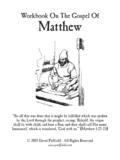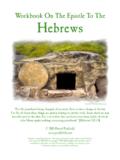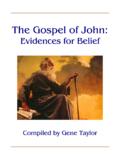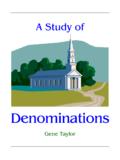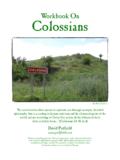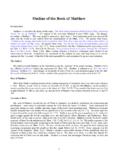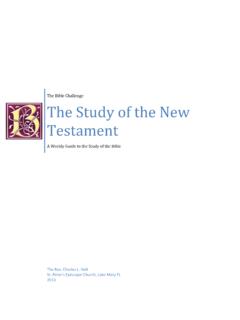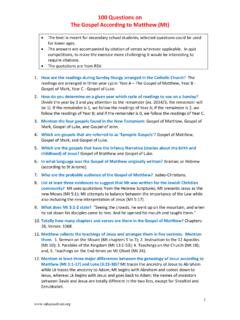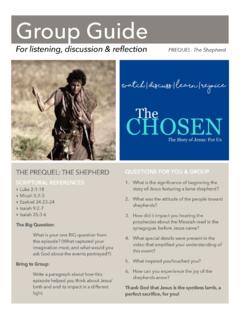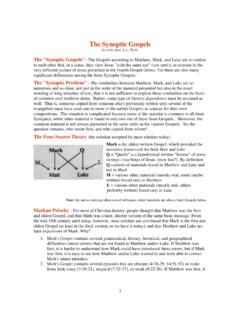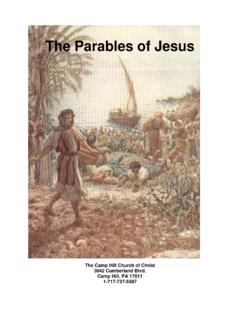Transcription of Capernaum, the City of Jesus - The Church Of Christ in ...
1 2017 David Padfield Scripture taken from the New King James Version. Copyright 1982 by Thomas Nelson, Inc. Used by permission. All rights Then they went into Capernaum, and immediately on the Sabbath He entered the synagogue and taught. (Mark 1:21)Capernaum, The City Of Jesus city of Capernaum was a small fishing village on the northwestern shore of the Sea of Galilee, about two miles west of the Jordan Hebrew name for this village is Ke far Nah um, which means, village of Nahum. this ancient town is not mentioned by name in the Old Testament, it is mentioned sixteen times in the New refers to Capernaum as our Lord s own city (Matt 9:1), for it became the center of His Galilean is interesting since He was not born in Capernaum, His parents did not live in there, and He did not grow up there!
2 Performed more miracles and preached more sermons in and around Capernaum than at any other place during His entire residents of this prosperous town were common people who made their living from fishing, agriculture, and trade. road leading to Damascus passed nearby, providing a commercial link with regions to the north and was also a garrison town, housing a detachment of Roman soldiers, under a centurion, along with government was in the vicinity of Capernaum that Jesus chose several of His and his brother Andrew (Mark 1:16 18). and James, the sons of Zebedee (Mark 1:19 20).
3 The tax collector (Mark 2:13 14). had often stayed in Peter s house in Capernaum and preached in the synagogue there which had been built by a Roman centurion ( luke 7:5). of its proximity to the Via Maris, Capernaum had a tax office over which matthew had presided (Matt 9:9). to His ascension into heaven, Jesus gave the Great Commission after the eleven disciples went away into Galilee, to the mountain which Jesus had appointed for them (Matt 28:16). was this city in Galilee so important in the first century? Way Of The of the greatest trade routes in the ancient world passed through Via Maris led from Damascus, via Hazor and Megiddo, down the Mediterranean coast to road is referred to as the way of the sea in both the Old and New Testament (Isa 9:1; Matt 4:15).
4 And traders throughout the world could be found there the traffic of the world passed through Capernaum sat on the International Highway running from Egypt to Babylon. Capernaum controlled trade along this route and would have added tax and tolls to travelers, traders and merchandise coming and going. This combined with the fishing industry and the industrial park s manufacturing of equipment such as grinding stones and olive presses from basalt stone made Capernaum rich. (Wiemers, Israel Field Book, 22) helps us to understand how the fame of Christ was spread throughout Syria and from Galilee, and from Decapolis, Jerusalem, Judea, and beyond the Jordan (Matt 4:23 25).
5 B. The city of Capernaum dates back to the 2nd century BCE, the time of the Hasmonean Dynasty. At the time of Jesus , Capernaum was a city of approximately 1,500 much larger than the small hamlet of Nazareth which may have had a population of only 400 people. Capernaum was also in close proximity to other Jewish towns and was conveniently close to the international trade route linking Damascus to the Mediterranean, the Via Maris as evidenced by the marble 2nd-century Roman milestone featured at the site. (Dintaman and Landis, Hiking The Jesus Trail, 122)C. Capernaum was a frontier town, not far from the Jordan and had, according to the latest estimates, between 1,000 and 1,500 inhabitants.
6 A garrison of mercenary soldiers under the supervision of a centurion was also stationed there. They served Herod Antipas. The mercenaries were probably not Romans, but might have been recruited from Phrygia, Gaul or Germany. They protected the frontier, provided back-up for the tax collectors, who had to collect the prescribed duties and generally saw to public order. One of the duties of the publicans was to collect the dues for the fish caught in the lake, whose owner was the king. The custom house of the publican, matthew , must have stood some place where the Via Maris passed close by the lake shore on the outskirts of the town.
7 (Pixner, With Jesus Through Galilee According to the Fifth Gospel, 35)Capernaum: The City Of 2D. Apart from Jerusalem, this is the most important of all the villages mentioned in the gospel accounts, for it was here that Jesus established his headquarters for the major portion of his public ministry. Three of his disciples were from Capernaum, and Peter and Andrew had evidently moved there from Bethsaida (Mark 1:29). According to archaeological investigations, the village spread out for a quarter of a mile along the lakeshore. It is probable that fishing was the major occupation of the inhabitants, and it is possible that basalt implements ( , olive presses and grain grinders) were produced there as well.
8 (Rasmussen, Zondervan Atlas of the Bible, 209)E. Observing how the Jewish leadership and Herod treated John the Baptist, Jesus strategically launched His own ministry in Galilee of the Gentiles, at Capernaum, which was by the sea (Matt. 4:12 16; cf. Isa. 9:1 2). It was not without reason that the Lord had indicated to Abraham that he must settle on this narrow strip of land that joined three continents. For thousands of years travelers from Africa to Europe, from Asia to Africa passed along the via maris, the way of the sea. Right by the locale of Capernaum they passed, and they continued to pass by throughout the days of Jesus .
9 By inaugurating His public ministry in Galilee of the Gentiles along the major international trade route, Jesus was making a statement. This land would serve as a springboard to all nations. The kingdom of God encompassed a realm that extended well beyond the borders of ancient Israel. As Paul so pointedly indicates, Abraham s promise from a new covenant perspective meant that he would be heir of the cosmos (Rom. 4:13). All nations, lands, and peoples would experience the blessings of this benevolent rule. (Robertson, Understanding the Land of the Bible, 11) Selection Of The was in the region of Galilee that Jesus began preaching the gospel of the kingdom of God (Mark 1:14 15).
10 Points out that Jesus began His ministry here in order to fulfill Old Testament prophecy (Matt 4:13 16; cf. Isa 9:1 2).2. The land of Zebulun and the land of Naphtali were portions of the Promised Land that had been given to those respective tribes during the days of Joshua (Josh 19:10 16, 32 39). was in the tribal allotment of selected Simon Peter and Andrew, two fishermen, while walking on the shores of the Sea of Galilee (Mark 1:16 18). also selected James and John, the sons of Zebedee, (Mark 1:19 21), though these two men were originally residents of Bethsaida (John 1:44).
